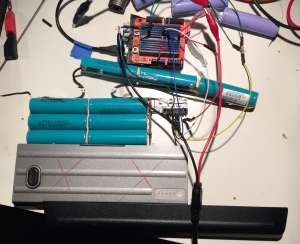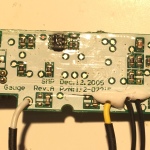I tore into a Dell Type TC030, 11.1v, 85 Wh pack I purchased for $1 from a PC recycling outfit. The pack label specifies that the cells were made in Korea, which means either LG or Samsung. Compatible types include PD685, RD301, TD117 or UD088.
The pack has a unique label with a barcode, and alpha-numeric equivalent, which reads, KR-0RD301-71763-77F-BOBX, REV A03.
Smart Battery System Data
The pack connector is: –. ??, BE?, ?? ,SDA, SCL, ++, ++
I was able to pull the following data with PackProbe after applying 9v across the power connector pins:
Manufacturer Name: SMP-LG2.6
Device Name: DELL PD68577F
Chemistry: LION
Design Capacity: 7800
Design Voltage: 11100
Manufacture Date (Y-M-D): 2007-7-15
Serial Number: 1584
Specification Info: 33
Cycle Count: 186
Voltage: 8.36
Full Charge Capacity: 2895
Remaining Capacity: 0
Relative Charge(%): 0
Absolute Charge(%): 0
Minutes remaining for full charge: -1
Cell 1 Voltage: -1
Cell 2 Voltage: -1
Cell 3 Voltage: -1
Cell 4 Voltage: -1
State of Health: -1
Battery Mode (BIN): 0b110000110000001
Battery Status (BIN): 0b101011010000
Charging Current: 6200
Charging Voltage: 13300
Temp: 26.05
Current (mA): 0
Cells
As we pull the pack apart, we get access to the main items of interest, the individual 18650 lithium ion cells. There are 9 of them, as I expected, given the size, voltage, and capacity of the pack. They are wrapped in turquoise shrinkwrap. The shrinkwrap has various codes individually printed on each cell. An example follows:
LGDB118650
G1342608358
EE142D6B1
The different cells I have vary in the underlined sections. Two share the EE142D7B1 code, and also only differ in the last two digits of the second line: G13427069[61,72].
These markings identify these cells as being manufactured by LG. The “B1” indicates that these are IC chemistry (Lithium Ion, Cobalt Oxide Cathode) cells with a capacity of 2,600 mAh. Someone may have decoded these marking further. The charging voltage reported by the pack made me suspect that these cells might have a higher charge termination voltage than the 4.2v typical of cells of this nominal capacity. After some digging I found a datasheet that seems to indicate the proper termination voltage is 4.35v.
The cells are wired in a 3s3p (a series of 3 banks of cells, with 3 cells in parallel in each bank). The physical configuration is somewhat unusual. The first bank of cells, starting at the positive end of the pack, is actually arranged in-line in an “outrigger” to the main pack, with interconnections within the bank and to the other banks using wires. The second and third banks are in a more traditional configuration. They are placed together, end to end, and the cells within each bank laid alongside eachother, tied together with nickel strips.
Before separating apart the cells, I checked voltages with a multimeter, and found the whole pack had a series voltage of 8.25v. The individual banks were, starting at the positive end, 3.78, 0.80, 3.70v. It seems like I had another crappy Dell pack.
When I pulled apart the first bank and tested the cells, I found more evidence that I had another shoddy Dell pack. While two of the cells had very similar voltages, one measured 0.12v. This really shouldn’t happen when the cells are arranged in parallel. I started to wonder if I was somehow damaging the cells when I tore the knickle strips off, perhaps I was deforming the metal at the negative end enough to break a weld to the battery electrode.
I was more cautious when I pulled apart the second bank. I checked individual cell voltages once I had the connections off the positive terminals, but before doing anything to the negative terminals. Voltages were still inconsistent. Two registered just 0v, with the remaining registering 0.79v. I took similar care with the third bank, but again found inconsistent voltages. Two measured 3.7v, but one only measured 0.16v.
Out of 9 cells, only 4 were worth charging and doing a discharge test. The results weren’t good, when charged to 4.2v and the discharged to 3v, all the cells were ~1,500mAh. These cells are supposed to be charged to 4.35v. I can’t find any tests comparing the capacity of these cells when new at 4.2v vs 4.35v, but there are reviews of some higher capacity LG cells that suggest a sacrifice of 10-15% of capacity, which would put these cells at 1,600-1,750mAh capacity, or about 2/3rds of their original capacity.
That’s a surprising loss after 186 cycles (The datasheet says these cells should retain 75% of original capacity after 300 cycles), though perhaps less surprising when you consider that the cells are 7 years old, and were probably being overloaded due to failures in adjacent cells.
I’ve seen similar inconsistencies in cell voltages and excessive cell wear in a number of 6-cell Dell packs I’ve torn down. At the time, I thought that part of the problem might have been weak welds to the cell terminals, which left some of the cells disconnected, but this pack had good, sturdy welds to all the terminals on all the cells, so something else may be at play.
Battery Management ICs and Circuit Boards
The electronics for the pack are more complicated than any of the other packs I’ve torn apart, being distributed among two different PCBs, which are arranged in perpendicular planes and connected with a multipin header. One board holds the main pack connector, and along with the MOSFETs and fuses that provide protection for the pack, and the main connections to the battery cells. It is labeled “Dell, Travis LF Conn. BD, Rev. A, Dec 12, 2005, SMP, P/N: 112-0222F.” The other board hold the battery management chipset, and connections to the thermistor and the leads to the individual cell banks. It is labelled: “Travis LF Gauge, Rev. A, SMP, Dec 12, 2005, P/N: 112-0221F.” There are two largish ICs. One has 24 pins and is labelled “bq29311P, 71K, CD2D.” This appears to be a bq29311 protection and balancing IC for 3-4 cells from Texas Instruments. The second has 38 pins is labelled “bq20857dbt, 73K, DLH5.” This appears to be a custom version of the bq2085 Smart Battery System compliant fuel gauge from TI.
Case Plastics
Inside the pack the pieces of plastic making up the case were labeled with date codes. The bottom plastic was labeled with one sticker reading “114-2267F, Rev:A, FOX, 2007.03.04.” A second sticker read “KSKZ, 2007.03.06, 114-2267F, PAINT”. The top half of the main compartment of the pack has one sticker “114-126F, REV: A, FOX, 2007.06.04”
The plastic for part of the “outrigger” had similar stickers reading: “114-1269F, REV: A, FOX, 07.05.14,” and “KSKZ, 2007.05.26, 114-1269F, PAINT.”
It’s interesting to take this into consideration with the pack manufacture date of 2007-07-15 retrieved with PackProbe. The plastics were manufactured a month or more before the pack was assembled, and one of the pieces was manufactured months before the other. It isn’t entirely surprising that the plastics were manufactured well before the pack. The most expensive component of the pack is the batteries, and the batteries can also be used for a variety of different pack designs, so I would expect higher turnover of cells. The plastics though are more specialized, and only work for a limited number of pack types and laptop models. There is also going to be some overhead in setting up a production run, so you’d want to balance the cost of unused inventory with the overhead cost on manufacturing. Even so, I’d think you’d tend to produce all the plastics for a given pack design at once, rather than months apart. It may be though that these packs are somewhat modular. It appears that a 6-cell and a 9-cell version of the pack may share some common pieces.




hello, I changed the battery of the laptop batteries, identical to that posted by you and want to know how do I reset?
Currently laptop no longer recognizes.
Thank you !!
hi
how you opend the battery case ?!